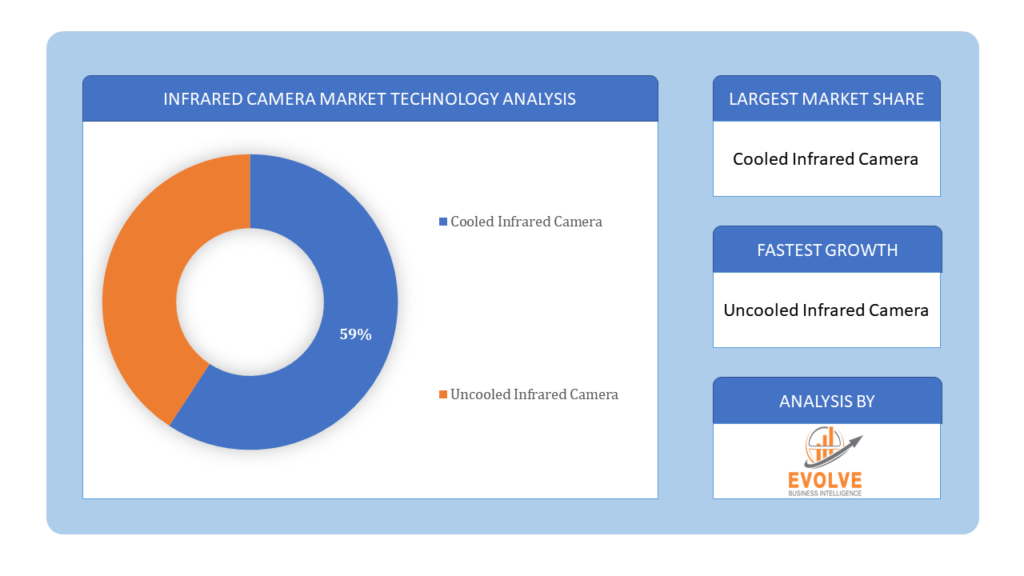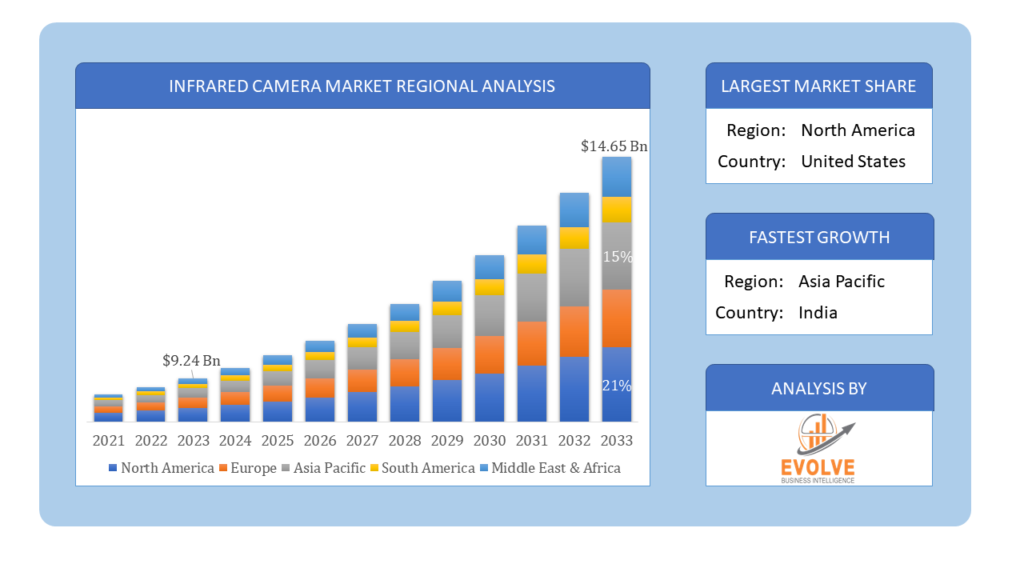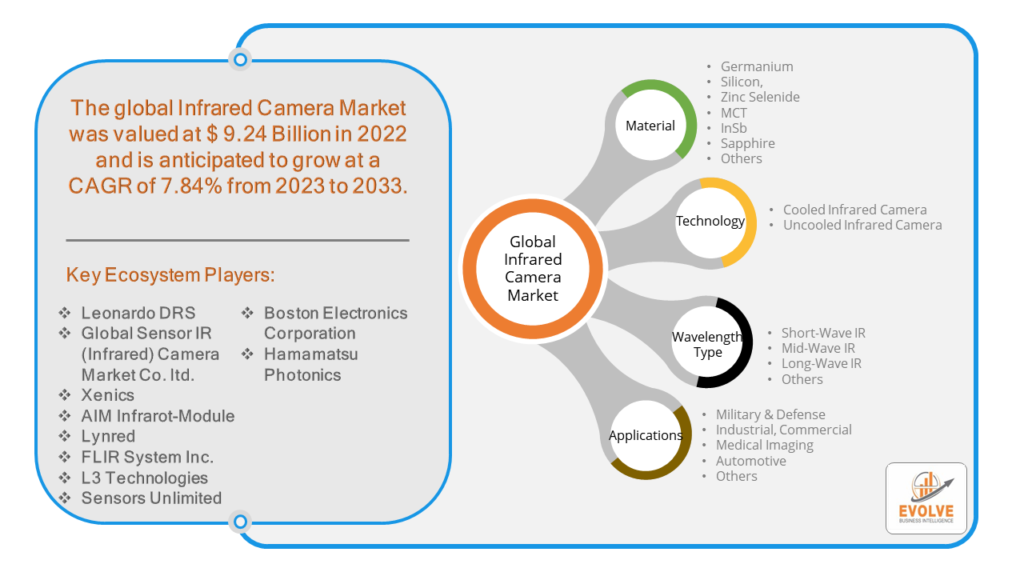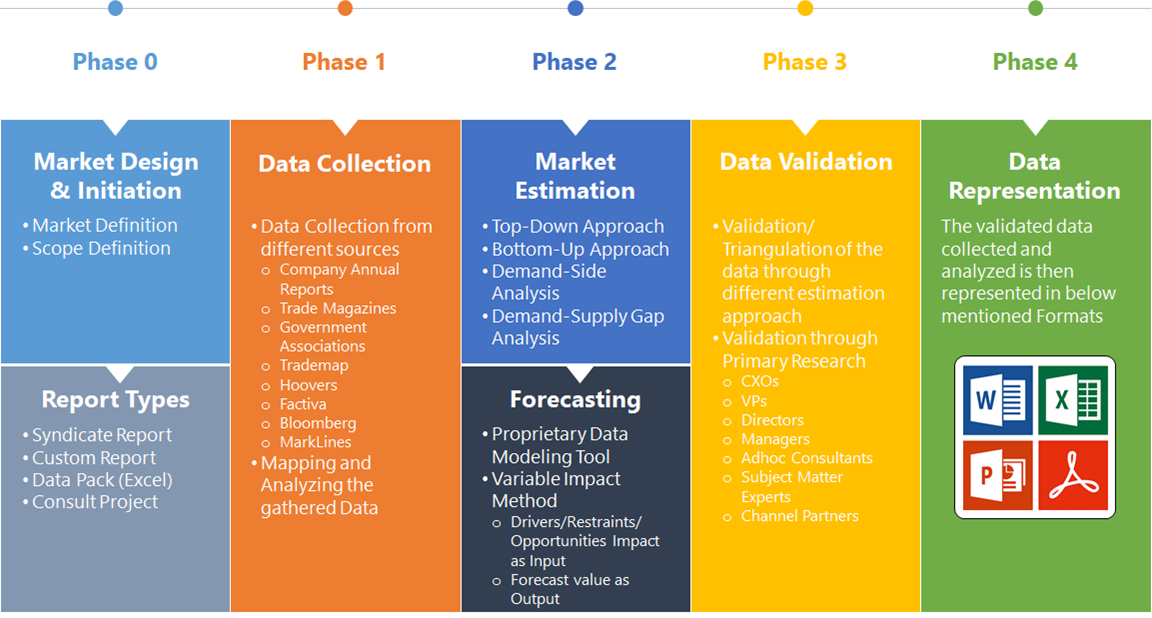Infrared Camera Market Overview
Infrared Camera Market Size is expected to reach USD 14.65 Billion by 2033. The Infrared Camera industry size accounted for USD 9.24 Billion in 2023 and is expected to expand at a compound annual growth rate (CAGR) of 7.84% from 2023 to 2033. The infrared camera market encompasses the production and sale of cameras that capture infrared radiation emitted by objects. These cameras are widely used in various sectors including security and surveillance, automotive, healthcare, and industrial applications. They provide thermal imaging capabilities, enabling users to detect temperature variations and identify anomalies not visible to the naked eye. Key players in the market include FLIR Systems, Axis Communications, and Fluke Corporation. Advancements in technology, such as the integration of AI and machine learning, are driving innovation and expanding the market’s potential. Growing concerns regarding security, safety, and predictive maintenance are further fueling the demand for infrared cameras globally.
Global Infrared Camera Market Synopsis
The Infrared Camera market experienced a detrimental effect due to the Covid-19 pandemic. The COVID-19 pandemic has had a mixed impact on the infrared camera market. While initial disruptions in manufacturing and supply chains affected the market negatively, the subsequent surge in demand for thermal imaging solutions for fever screening, social distancing enforcement, and infection control measures has driven significant growth. Industries such as healthcare, transportation, and manufacturing have increasingly adopted infrared cameras to mitigate the spread of the virus, leading to a rapid expansion in market size despite initial setbacks.
Global Infrared Camera Market Dynamics
The major factors that have impacted the growth of Infrared Camera are as follows:
Drivers:
⮚ Technological Advancements
Continuous advancements in infrared imaging technology have led to the development of high-resolution, compact, and affordable infrared cameras. These advancements have expanded the application areas of infrared cameras across various industries such as automotive, aerospace, healthcare, and surveillance.
Restraint:
- Data Privacy and Security Concerns
Infrared imaging technology raises concerns regarding data privacy and security, particularly in applications involving surveillance and monitoring of individuals or sensitive locations. Ensuring compliance with data protection regulations and implementing robust security measures is crucial to mitigate these concerns and build trust among end-users.
Opportunity:
⮚ Advancements in Healthcare Imaging
Infrared cameras hold immense potential in the healthcare industry for various applications, including medical imaging, thermography, and disease detection. With ongoing advancements in sensor technology and image processing algorithms, infrared cameras can offer improved resolution, sensitivity, and accuracy, enabling early detection of health conditions and enhancing patient care.
Infrared Camera Market Segment Overview
By Material
Based on the Material, the market is segmented based on Germanium, Silicon, Zinc Selenide, MCT, InSb, Sapphire and Others. Germanium stands out as the dominant choice. Known for its excellent optical properties and high transmission in the infrared spectrum, Germanium serves as a preferred material for infrared lenses and windows in various applications, including military, aerospace, and industrial imaging. Its superior performance and wide availability contribute to its prominence in the market.
By Technology
 Based on Technology, the market has been divided into Cooled Infrared Camera and Uncooled Infrared Camera. In the infrared camera market segmented by technology, Uncooled Infrared Cameras currently dominate the landscape. Their widespread adoption is attributed to their lower cost, compact size, and reduced power consumption compared to their cooled counterparts. Uncooled cameras find extensive applications in thermography, surveillance, automotive safety systems, and industrial monitoring, driving their market dominance.
Based on Technology, the market has been divided into Cooled Infrared Camera and Uncooled Infrared Camera. In the infrared camera market segmented by technology, Uncooled Infrared Cameras currently dominate the landscape. Their widespread adoption is attributed to their lower cost, compact size, and reduced power consumption compared to their cooled counterparts. Uncooled cameras find extensive applications in thermography, surveillance, automotive safety systems, and industrial monitoring, driving their market dominance.
By Wavelength Type
Based on the Wavelength Type, the market has been divided into Short-Wave IR, Mid-Wave IR, Long-Wave IR, and Others. In the infrared camera market, segmentation by wavelength type reveals distinct dominance in Short-Wave IR and Long-Wave IR segments. Short-Wave IR cameras excel in applications requiring high-resolution imaging in diverse environmental conditions, while Long-Wave IR cameras are preferred for thermal imaging tasks, offering superior sensitivity and range.
By Application
Based on Application, the market has been divided into Military & Defense, Industrial, Commercial, Medical Imaging, Automotive, and Others. the Military & Defense sector dominates due to its extensive use in surveillance, reconnaissance, and target acquisition applications, bolstered by increasing defense spending globally. The Industrial segment also holds a significant share driven by demand for predictive maintenance, quality control, and process monitoring solutions across manufacturing, energy, and infrastructure sectors
Global Infrared Camera Market Regional Analysis
Based on region, the market has been divided into North America, Europe, Asia-Pacific, the Middle East & Africa, and Latin America. The area of Asia-Pacific is anticipated to dominate the market for the usage of Infrared Camera , followed by those in North America and Europe.
 Infrared Camera Asia-Pacific Market
Infrared Camera Asia-Pacific Market
The Asia-Pacific region holds a dominant position in the Infrared Camera market. The Asia-Pacific region’s infrared camera market is expanding significantly, largely because of government programs and massive investments aimed at advancing the military and defense industry and acquiring the best military surveillance equipment. The IR camera market is seeing expansion due to various causes, such as the increasing need for smart electronics and the manufacturing sector’s rapid development. Due to the abundance of industrial and process sectors, historical landmarks, and both residential and commercial buildings, the North American area has led the infrared camera market in 2019.
Infrared Camera North America Market
The North America region is witnessing rapid growth and emerging as a significant market for the Infrared Camera industry. In North America, the infrared camera market showcases robust growth driven by increasing adoption across diverse industries such as defense, surveillance, healthcare, and automotive. The region’s technologically advanced infrastructure and stringent security regulations further bolster market demand. Additionally, ongoing advancements in infrared camera technology, coupled with rising investments in research and development, continue to fuel market expansion in North America.
Competitive Landscape
The competitive landscape includes key players (tier 1, tier 2, and local) having a presence across the globe. Companies such as Leonardo DRS, Global Sensor IR (Infrared) Camera Market Co. ltd., Xenics, AIM Infrarot-Module, and Lynred are some of the leading players in the global Infrared Camera Industry. These players have adopted partnership, acquisition, expansion, and new product development, among others as their key strategies.
Key Market Players:
- Leonardo DRS
- Global Sensor IR (Infrared) Camera Market Co. ltd.
- Xenics
- AIM Infrarot-Module
- Lynred
- FLIR System Inc.
- L3 Technologies
- Sensors Unlimited
- Boston Electronics Corporation
- Hamamatsu Photonics
Key Development:
In March 2020, FLIR Systems announced FLIR A400/A700 Thermal Smart Sensor and Thermal Image Streaming fixed camera solutions which is used to monitor equipment, production lines, critical infrastructure, and screening for elevated skin temperatures. These cameras provide accurate temperature monitoring in product development, waste management, manufacturing process control, and Environmental, Health and Safety (EHS) improvements.
Scope of the Report
Global Infrared Camera Market, by Material
- Germanium
- Silicon
- Zinc Selenide
- MCT
- InSb
- Sapphire
- Others
Global Infrared Camera Market, by Technology
- Cooled Infrared Camera
- Uncooled Infrared Camera
Global Infrared Camera Market, by Wavelength Type
- Short-Wave IR
- Mid-Wave IR
- Long-Wave IR
- Others
Global Infrared Camera Market, by Application
- Military & Defense
- Industrial, Commercial
- Medical Imaging
- Automotive
- Others
Global Infrared Camera Market, by Region
- North America
- US
- Canada
- Mexico
- Europe
- UK
- Germany
- France
- Italy
- Spain
- Benelux
- Nordic
- Rest of Europe
- Asia Pacific
- China
- Japan
- South Korea
- Indonesia
- Austalia
- Malaysia
- India
- Rest of Asia Pacific
- South America
- Brazil
- Argentina
- Rest of South America
- Middle East & Africa
- Saudi Arabia
- UAE
- Egypt
- South Africa
- Rest of Middle East & Africa
| Parameters | Indicators |
|---|---|
| Market Size | 2033: $14.65 Billion |
| CAGR | 7.84% CAGR (2023-2033) |
| Base year | 2022 |
| Forecast Period | 2023-2033 |
| Historical Data | 2021 |
| Report Coverage | Revenue Forecast, Competitive Landscape, Growth Factors, and Trends |
| Key Segmentations | Material, Technology, Wavelength Type, Application |
| Geographies Covered | North America, Europe, Asia-Pacific, Latin America, Middle East, Africa |
| Key Vendors | Leonardo DRS, Global Sensor IR (Infrared) Camera Market Co. ltd., Xenics, AIM Infrarot-Module, Lynred, FLIR System Inc., L3 Technologies, Sensors Unlimited, Boston Electronics Corporation, Hamamatsu Photonics |
| Key Market Opportunities | Growing E-commerce Industry |
| Key Market Drivers | Increasing Consumer Demand Technological Advancements |
REPORT CONTENT BRIEF:
- High-level analysis of the current and future Infrared Camera Industry trends and opportunities
- Detailed analysis of current market drivers, restraining factors, and opportunities analysis in the future
- Historical market size for the year 2021, and forecast from 2023 to 2033
- Infrared Camera market share analysis for each segment
- Competitor analysis with a comprehensive insight into its product segment, financial strength, and strategies adopted.
- Identifies key strategies adopted by the key players including new product development, mergers and acquisitions, joint ventures, collaborations, and partnerships.
- To identify and understand the various factors involved in the global Infrared Camera market affected by the pandemic
- To provide year-on-year growth from 2022 to 2033
- To provide short-term, long-term, and overall CAGR comparison from 2022 to 2033.
- Provide Total Addressable Market (TAM) for the Global Infrared Camera Market.





